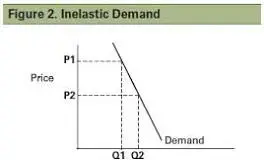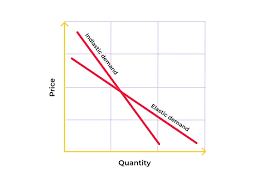The distinction between elastic and inelastic demand is central to learning economics. These concepts describe how a change in price or some other characteristic affects the quantity demanded of a product. If you are struggling with these topics, the assignment helpers are well-equipped to offer you the required help. This blog will explain elasticity and inelasticity with examples and why they are essential.
What is meant by the term’ Elasticity of Demand’?
The elasticity of demand is defined as the extent to which the quantity demanded of a particular good changes, given a change in one of its determinant factors like price, income, or similar goods. If a small change in the price brings about a significant change in the quantity demanded, it is said that demand is elastic.
Example of Elastic Demand:
For instance, take high-end gadgets such as mobile phones, cameras, and iPods. If the price of a new smartphone decreases to 10%, but the quantity demanded rises to 30%, the demand is elastic. Price is sensitive, and people respond to price changes in a certain way.
What is meant by the Degree of Inelasticity of Demand?
It refers to a situation where a change in price or other factors has little to no impact on the quantity demanded. In other words, the overall consumption of the product does not fluctuate significantly based on the prices of the product.

Example of Inelastic Demand:
Items like medicine or staples, for instance, usually exhibit inelastic demand. For example, if the price of insulin rises by 20%, the quantity demanded is not significantly affected since people with diabetes require the product irrespective of its price.
5 Key Differences Between Elasticity and Inelasticity of Demand

1. Sensitivity to Price Changes
With elastic demand, consumers can easily alter their consumption to match prices. This means that even a slight drop in prices can result in a considerable increase in demand.
Inelastic demand, for its part, indicates that customers are not very sensitive to price alterations. Not even large price changes significantly impact the quantity demanded.
2. Type of Goods
Elastic demand is normally related to inelastic, luxury, or necessary products. These are those that consumers can easily go without or find an inferior substitute in case the prices are raised.
Necessity or staple goods are usually associated with inelastic demand. These are goods that any consumer will have to purchase regardless of the price, such as water, electricity, or necessary groceries.
3. Revenue Implications
Elasticity is necessary for the business community to determine the appropriate price for its consumers. Reducing prices in an elastic market increases total revenue because the increased quantity demanded offsets the effect of the lower price.
This is a market structure where firms can raise prices, and at the same time, the sales volume does not much affect the total revenue.
4. Availability of Substitutes
Products with elastic demand usually are easily substituted for other products. Consumers are not loyal to one soda brand, so if one brand raises its price, they can easily move to another.
Products characterized by inelastic demand usually have few, if any, close substitutes. For instance, there are no close substitutes for specific categories of prescription drugs.
5. Short-Term vs. Long-Term Perspective
In the long run, consumers can switch to other products or modify their consumption patterns, making the demand for goods more elastic. For instance, if gasoline prices persist, consumers might switch to using public transport.
In the long run, demand is less inelastic because consumers cannot quickly alter their demand levels. However, over time, demand can become somewhat elastic owing to the emergence of new substitutes.
Why Understanding These Differences Matters
For Students:
Understanding relative elasticity and inelasticity of demand is a critical concept for economics students. These concepts are basic for market analysis and consumer behaviors.
For Businesses:
Companies employ these concepts in setting prices and marketing their products. Awareness of a product’s demand elasticity or inelasticity helps make practical decisions affecting profit margins.
For Policymakers:
Policymakers use elasticity to anticipate the implications of taxation and regulation. For example, a tax can target products whose demand is inelastic, thus collecting revenues without significantly cutting down consumption.
In what ways Assignment Helpers can be helpful
Do you often say, ‘I wish I could hire someone to take my online class for me’? Many students need help grasping these concepts, and this is where assignment helpers come in.
Advantages of Using Assignment Writers
Expert Knowledge: Seek help from experts who know about the elasticity and inelasticity of demand.
Time Management: Complete your assignments more easily and quickly with the assistance of professionals who will do the work for you.
Higher Grades: Hiring professionals can make things easier to comprehend and increase class performance.
Customized Assistance: Get assistance individualized for your situation and academic goals.
Real-World Applications
Assignment helpers can also use real-life examples and case scenarios to make these concepts more understandable. Whether it concerns using a specific form, such as demand for a new tech gadget or the effect of price changes on fuel, professional help can improve your knowledge.
The elasticity and inelasticity of demand remain relevant to students, businesspeople, and policymakers. These concepts aid in understanding consumer behavior, determining prices, and informing economic policies. However, kindly seek assistance from assignment helpers if you need help comprehending these topics. Assignment helpers can help you with the stance required to succeed in your education and academic endeavors.
Therefore, when next you find yourself contemplating, ‘I need help with taking my online class’, you should know that help is just around the corner. With the proper guidance from assignment helpers, you can master these complex concepts and pave the way for academic success.


